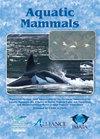Notable Stingray Spine-Associated Strandings Involving Two Female Bottlenose Dolphins in Florida and Massachusetts, USA, in the Context of Literature and Database Reviews
IF 0.9
4区 生物学
Q4 MARINE & FRESHWATER BIOLOGY
引用次数: 0
Abstract
Trauma from stingray spines (caudal barbs) has been intermittently documented as a cause of mild to fatal illness in odontocetes, particularly bottlenose dolphins (Tursiops truncatus), as well as in pinnipeds, sirenians, the loggerhead sea turtle, great white shark, and cobia. Although stingray spines have been noted to cause serious injury to various organ systems, their potential involvement in cetacean reproductive tract pathology has not been previously described. In North America, published descriptions of wild cetacean strandings associated with stingray spines have all involved bottlenose dolphins in the southeastern United States, plus a bottlenose dolphin and a common dolphin (Delphinus delphis) in Mexico. In 2018, uterine rupture was observed in a gravid bottlenose dolphin found deceased in Florida with stingray spine penetration into the abdominal cavity. Gross necropsy and histopathology findings were compatible with the stingray spine being involved with the rupture. To provide fuller insight into the case, a scientific literature review was conducted, and results of an unpublished 1998 necropsy involving a coastal female bottlenose dolphin that stranded in the northeastern state of Massachusetts with stingray spine presence was reviewed. Additionally, a query of the nationwide U.S. marine mammal stranding database was conducted for stingray spine-associated cetacean strandings from 1995 to 2019. Of 61 cetacean strandings revealed in the query to involve stingray spine presence, 59 were bottlenose dolphins from the southeastern U.S. states, plus Puerto Rico and Virginia; a bottlenose dolphin in southern California and a short-finned pilot whale (Globicephala macrorhynchus) were also noted. Query results did not support a bottlenose dolphin sex predilection for stingray spine-associated strandings; most such strandings involved adults. Behavioral, environmental, anthropogenic, and climatic events may influence marine mammal–stingray interactions. Continued vigilance for stingray spine-associated pathologic changes is warranted during marine mammal stranding investigations at diverse geographic sites.在文献和数据库回顾的背景下,美国佛罗里达州和马萨诸塞州的两只雌性宽吻海豚与黄貂鱼脊柱相关的搁浅事件值得注意
黄貂鱼刺(尾端倒刺)造成的创伤断断续续地记录为齿形动物,特别是宽吻海豚(Tursiops truncatus),以及鳍足类动物,海蛞蝓,红海龟,大白鲨和哥伦比亚的轻微至致命疾病的原因。虽然已经注意到黄貂鱼刺对各种器官系统造成严重伤害,但它们在鲸类生殖系统病理中的潜在参与尚未被描述。在北美,已发表的关于与黄貂鱼刺有关的野生鲸类搁浅的描述都涉及美国东南部的宽吻海豚,以及墨西哥的宽吻海豚和普通海豚(Delphinus delphis)。2018年,在佛罗里达州发现的一只怀孕的宽吻海豚死亡时,观察到子宫破裂,黄貂鱼的脊柱刺入腹腔。大体尸检和组织病理学检查结果与黄貂鱼脊柱与破裂有关。为了更全面地了解这个案例,我们进行了一项科学文献综述,并对1998年未发表的一项尸检结果进行了回顾,该尸检涉及一只搁浅在马萨诸塞州东北部的沿海雌性宽吻海豚,有黄貂鱼的脊椎。此外,对美国全国海洋哺乳动物搁浅数据库进行了查询,以了解1995年至2019年与黄貂鱼脊椎相关的鲸类搁浅情况。在61起与黄貂鱼脊椎有关的鲸类搁浅事件中,59起是来自美国东南部各州、波多黎各和弗吉尼亚州的宽吻海豚;南加州的宽吻海豚和短鳍领航鲸(Globicephala macrohynchus)也被注意到。查询结果不支持宽吻海豚对黄貂鱼脊椎相关搁浅的性别偏好;大多数搁浅的都是成年人。行为、环境、人为和气候事件可能影响海洋哺乳动物与黄貂鱼的相互作用。在不同地理位置的海洋哺乳动物搁浅调查期间,对黄貂鱼脊椎相关病理变化的持续警惕是有必要的。
本文章由计算机程序翻译,如有差异,请以英文原文为准。
求助全文
约1分钟内获得全文
求助全文
来源期刊

Aquatic Mammals
MARINE & FRESHWATER BIOLOGY-ZOOLOGY
CiteScore
1.60
自引率
16.70%
发文量
99
审稿时长
>12 weeks
期刊介绍:
Aquatic Mammals is a peer-reviewed journal sponsored by the European Association for Aquatic Mammals (EAAM), the Alliance of Marine Mammal Parks and Aquariums (AMMPA), and the International Marine Animal Trainers’ Association (IMATA). Aquatic Mammals publishes articles related to marine mammals (whales, dolphins, seals, fur seals, sea lions, walrus, dugongs, manatees, sea otters, and polar bears). Topics of publication on both captive animals and wild marine mammals include aspects of husbandry; behavior; conservation; veterinary medicine; anatomy; physiology; training; population trends; and the effects of pollution, climate change, and noise.
 求助内容:
求助内容: 应助结果提醒方式:
应助结果提醒方式:


